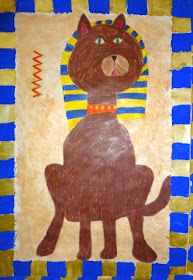This isn't a new project. I just like it too much to get rid of it. The end results are super cool, it reinforces basic skills with three types of media, and my first graders love it. That's why I teach it year after year.
Space is one of those topics that almost all kids love. I get into some basic space knowledge with this lesson and also spend some time describing several images of space shuttles/rockets/etc. I then allow the students to get into their own artwork.
I typically post my full lesson plan, but this one is simple enough that I'll just post the steps right here. Enjoy!






























































